Twelve Olympians
In the ancient Greek religion and Greek mythology, the Twelve Olympians are the major deities of the Greek pantheon, commonly considered to be Zeus, Hera, Poseidon, Demeter, Athena, Apollo, Artemis, Ares, Aphrodite, Hephaestus, Hermes and either Hestia, or Dionysus.[1] Hades and Persephone were sometimes included as part of the twelve Olympians (primarily due to the influence of the Eleusinian Mysteries), although in general Hades was excluded, because he resided permanently in the underworld and never visited Olympus.
Concept

The Twelve Olympians, also known as the Dodekatheon (Greek: Δωδεκάθεον,δώδεκα,[3][4] dōdeka, "twelve" and θεοί, theoi, "gods"), were the principal deities of the Greek pantheon, said to reside atop Mount Olympus. The Olympians gained their supremacy in a war of gods in which Zeus led his siblings to victory over the Titans.
The concept of the "Twelve Gods" is older than any extant Greek or Roman sources.[5] The gods meet in council in the Homeric epics, but the first ancient reference to religious ceremonies for the Olympians collectively is found in the Homeric Hymn to Hermes. The Greek cult of the Twelve Olympians can be traced to 6th-century BC Athens and probably has no precedent in the Mycenaean period. The Altar of the Twelve Gods at Athens is usually dated to the archonship of the younger Pesistratos, in 522/521 BC.
In ancient Greek religion, the "Olympian Gods" and the "Cults of Twelve Gods" were often relatively distinct concepts.[6]
Membership
While the number was fixed at twelve,[7] there was considerable variation as to which deities were included.[8] However, the twelve as most commonly portrayed in art and poetry were Zeus, Hera, Poseidon, Demeter, Athena, Apollo, Artemis, Ares, Aphrodite, Hephaestus, Hermes and either Hestia, or Dionysus.
Hades, known in the Eleusinian tradition as Pluto, was not usually included among the Olympians because his realm was the underworld. Plato connected the Twelve Olympians with the twelve months, and implies that he considered Pluto one of the twelve in proposing that the final month be devoted to him and the spirits of the dead.[9][10] In Phaedrus, Plato seems to exclude Hestia from the rank of "the twelve great gods".[11]
At Olympia there were six altars dedicated to six pairs of gods: Zeus and Poseidon, Hera and Athena, Hermes and Apollo, the Charites and Dionysus, Artemis and Alpheus, and Cronus and Rhea.[12] The historian Herodotus states that Heracles was included as one of the Twelve by some.[13] At Kos, Heracles and Dionysus are added to the Twelve, and Ares and Hephaestus are not.[14] For Pindar,[15] the Bibliotheca, and Herodorus, Heracles is not one of the Twelve Gods, but the one who established their cult.[4] Lucian (2nd century AD) includes Heracles and Asclepius as members of the Twelve, without explaining which two had to give way for them.
Hebe, Helios, Selene, Eos, Eros and Persephone are other important gods and goddesses who are sometimes included in a group of twelve. Eros is often depicted alongside the other twelve, especially his mother Aphrodite, but not usually counted in their number.
The Roman poet Ennius gives the Roman equivalents (the Dii Consentes) as six male-female complements,[10] preserving the place of Vesta (Greek Hestia), who played a crucial role in Roman religion as a state goddess maintained by the Vestals.
List
The Twelve Olympians
| Greek name | Roman name | Image | Functions and attributes |
|---|---|---|---|
| Zeus | Jupiter |  | King of the gods and ruler of Mount Olympus; god of the sky, lightning, thunder, law, order, justice. Youngest child of the Titans Cronus and Rhea. Symbols include the thunderbolt, eagle, oak tree, scepter, and scales. Brother and husband of Hera, although he had many lovers, also brother of Poseidon, Hades, Demeter, and Hestia. |
| Hera | Juno | 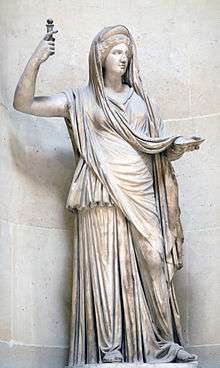 | Queen of the gods and the goddess of marriage and family. Symbols include the peacock, cuckoo, and cow. Youngest daughter of Cronus and Rhea. Wife and sister of Zeus. Being the goddess of marriage, she frequently tried to get revenge on Zeus' lovers and their children. |
| Poseidon | Neptune |  | God of the seas, earthquakes, and tidal wave. Symbols include the horse, bull, dolphin, and trident. Middle son of Cronus and Rhea. Brother of Zeus and Hades. Married to the Nereid Amphitrite, although, like most male Greek Gods, he had many lovers. |
| Demeter | Ceres |  | Goddess of fertility, agriculture, nature, and the seasons. Symbols include the poppy, wheat, torch, cornucopia, and pig. Middle daughter of Cronus and Rhea. |
| Athena | Minerva |  | Goddess of wisdom, reason, intelligent activity, literature, handicrafts and science, defense and strategic warfare. Symbols include the owl and the olive tree. Daughter of Zeus and the Oceanid Metis, she rose from her father's head fully grown and in full battle armor after he swallowed her mother. |
| Apollo[A] | Apollo[A] | 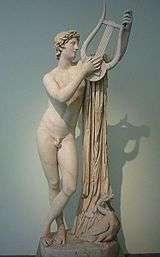 | God of light, prophecy, inspiration, poetry, music and arts, medicine and healing. Son of Zeus and Leto. Symbols include the sun, lyre, swan, and mouse. Twin brother of Artemis. |
| Artemis | Diana |  | Goddess of the hunt, virginity, archery, the moon, and all animals. Symbols include the moon, deer, hound, she-bear, snake, cypress tree, and bow and arrow. Daughter of Zeus and Leto and twin sister of Apollo. |
| Ares | Mars |  | God of war, violence, and bloodshed. Symbols include the boar, serpent, dog, vulture, spear, and shield. Son of Zeus and Hera, all the other gods (except Aphrodite) despised him. His Latin name, Mars, gave us the word "martial." |
| Aphrodite | Venus | 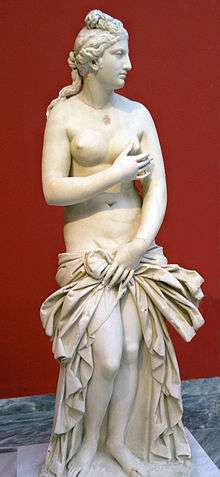 | Goddess of love, beauty, and desire. Symbols include the dove, bird, apple, bee, swan, myrtle, and rose. Daughter of Zeus and the Oceanid Dione, or perhaps born from the sea foam after Uranus' semen dripped into the sea after being castrated by his youngest son, Cronus, who then threw his father's genitals into the sea. Married to Hephaestus, although she had many adulterous affairs, most notably with Ares. Her name gave us the word "aphrodisiac", while her Latin name, Venus, gave us the word "venereal".[B] |
| Hephaestus | Vulcan |  | Master blacksmith and craftsman of the gods; god of fire and the forge. Symbols include fire, anvil, axe, donkey, hammer, tongs, and quail. Son of Hera, either by Zeus or alone. Married to Aphrodite, though unlike most divine husbands, he was rarely ever licentious. His Latin name, Vulcan, gave us the word "volcano." |
| Hermes | Mercury |  | Messenger of the gods; god of commerce, thieves, eloquence and streets. Symbols include the caduceus (staff entwined with two snakes), winged sandals and cap, stork, and tortoise (whose shell he used to invent the lyre). Son of Zeus and the nymph Maia. The second-youngest Olympian, just older than Dionysus. |
| Hestia | Vesta | | Goddess of the hearth and of the right ordering of domesticity and the family; she was born into the first Olympian generation and was one of the original twelve Olympians. Some lists of the Twelve Olympians omit her in favor of Dionysus, but the speculation that she gave her throne to him in order to keep the peace seems to be modern invention. She is the first child of Cronus and Rhea, eldest sister of Hades, Demeter, Poseidon, Hera, and Zeus. |
| Dionysus | Bacchus | 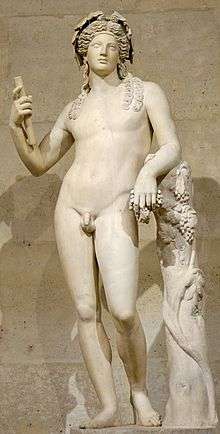 | God of wine, celebrations, and ecstasy. Patron god of the art of theatre. Symbols include the grapevine, ivy, cup, tiger, panther, leopard, dolphin, goat, and pinecone. Son of Zeus and the mortal Theban princess Semele. Married to the Cretan princess Ariadne. The youngest Olympian god, as well as the only one to have a mortal mother. |
- Notes
- ^ Romans also associated Phoebus with Helios and the sun itself,[16][17] however, they also used the Greek name Apollon in a Latinized form Apollo.[18]
- ^ According to an alternate version of her birth, Aphrodite was born of Uranus, Zeus' grandfather, after Cronus threw his castrated genitals into the sea. This supports the etymology of her name, "foam-born". As such, Aphrodite would belong to the same generation as Cronus, Zeus' father, and would be Zeus' aunt. See the birth of Aphrodite
Other Olympians
The following gods and goddess are sometimes included as one of the twelve Olympians.
| Greek Name | Roman Names | Image | Functions and Attributes |
|---|---|---|---|
| Hades (or Pluto) | Orcus (or Dis Pater) | 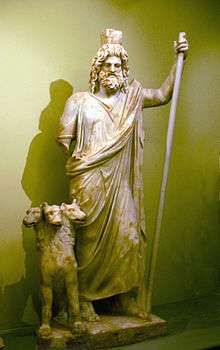 | God of the Underworld, dead and the riches under the Earth; he was born into the first Olympian generation, the elder brother of Zeus, Poseidon, Hera, and Demeter, and younger brother of Hestia, but as he lives in the Underworld rather than on Mount Olympus, he is typically not included amongst the twelve Olympians. |
| Heracles | Hercules |  | A divine hero, the son of Zeus and Alcmene, foster son of Amphitryon and great-grandson (and half-brother) of Perseus (Περσεύς). He was the greatest of the Greek heroes, a paragon of masculinity and a champion of the Olympian order against chthonic monsters. |
| Persephone | Proserpina |  | Queen of the Underworld and a daughter of Demeter and Zeus. Also goddess of spring time. She became the consort of Hades, the god of the underworld, when he kidnapped her. Demeter, driven to distraction by the disappearance of her daughter, neglected all of the earth so that nothing would grow. Zeus eventually ordered Hades to allow Persephone to leave the underworld and rejoin her mother. Hades did this, but because Persephone had eaten six of the twelve pomegranate seeds in the underworld when Hades first kidnapped her, she had to spend six months in the underworld each year. This created the seasons when for six months everything grows and flourishes then for the other six months everything wilts and dies. Her symbols include the pomegranate, willow tree, waterfalls, rivers and springs. |
| Asclepius | Vejovis | 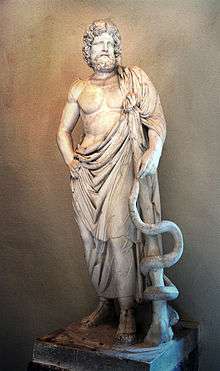 | The god of medicine and healing. He represents the healing aspect of the medical arts; his daughters are Hygieia ("Health"), Iaso ("Medicine"), Aceso ("Healing"), Aglæa/Ægle ("Healthy Glow"), and Panacea ("Universal Remedy"). He is the son of Apollo and Coronis. |
| Eros | Cupid | 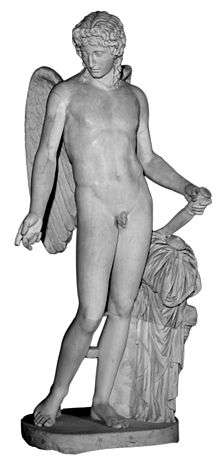 | The god of sexual love and beauty. He was also worshipped as a fertility deity, son of Aphrodite and Ares. He was depicted often as carrying a lyre or bow and arrow. He is often accompanied by dolphins, roses, and torches. |
| Hebe | Juventas | 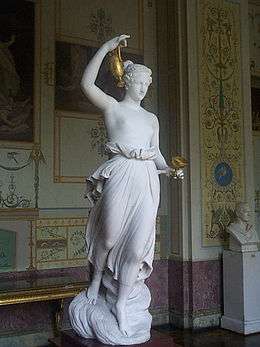 | She is the daughter of Zeus and Hera. Hebe was the cupbearer for the gods and goddesses of Mount Olympus, serving their nectar and ambrosia, until she was married to Heracles. She is the goddess of youth. |
| Pan | Faunus or Silvanus | 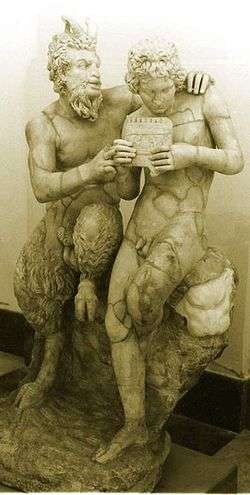 | The god of nature, the wild, shepherds and flocks, mountains, hunting, the forest, and rustic music, as well as the companion of the nymphs. The root of the word 'panic' comes from the god Pan and his great war cry that instilled fear and panic into all his enemies . |
Minor residents of Mount Olympus

The following gods and goddesses were not usually counted as Olympians, although they had close ties to them.
- Aeolus – King of the winds, keeper of the Anemoi, master of the seasonal winds.
- Amphitrite – Queen of the Sea, mother of Triton and wife of Poseidon.
- Anemoi – The personifications of the four wind directions (North, South, East and West).
- Aura – Goddess of cool breezes and fresh air.
- Bia – Personification of force.
- Circe – minor goddess of magic, not to be confused with Hecate.
- Deimos – God of terror, son of Ares and brother of Phobos.
- Dione – Oceanid; Mother of Aphrodite by Zeus in Homer's version.
- Eileithyia – Goddess of childbirth; daughter of Hera and Zeus.
- Enyo – A goddess of warfare, companion of Ares. She was also the sister of Ares in some cases. In those cases, her parents are Zeus and Hera.
- Eos – Personification of dawn.
- Eris – Goddess of discord and strife.
- Ganymede – Cupbearer of the gods' palace at Olympus.
- Graces – Goddesses of beauty and attendants of Aphrodite and Hera.
- Harmonia – Goddess of concord and harmony, opposite of Eris, daughter of Aphrodite.
- Hecate – Goddess associated with magic, witches and crossroads.
- Helios – Titan; personification of the sun.
- Horae – Wardens of Olympus.
- Hypnos – God of sleep, father of Morpheus and son of Nyx.
- Iris – Personification of the Rainbow, also the messenger of Olympus along with Hermes.
- Kratos – Personification of power.
- Leto – Titaness of the unseen; the mother of Apollo and Artemis.
- Moirai – The 'Fates'. Clotho (the spinner), Lachesis (the allotter) and Atropos (the unturnable).
- Momus – God of satire, mockery, satires, and poets.
- Morpheus – God of dreams.
- Muses – Nine goddesses of science and arts. Their names are Calliope, Urania, Clio, Polyhymnia, Melpomene, Terpsichore, Thalia, Euterpe, and Erato.
- Nemesis – Greek goddess of retribution and revenge, daughter of Nyx.
- Nike – Goddess of victory.
- Nyx – Goddess of night.
- Paean – Physician of the gods.
- Perseus – Son of Zeus and Danae, slayer of Medusa, the legendary founder of Mycenae and of the Perseid dynasty.
- Phantasos - God of surreal dreams.
- Phobos – God of fear, son of Ares and brother of Deimos.
- Selene – Titaness; personification of the moon.
- Styx – Goddess of the River Styx, the river where gods swear oaths on.
- Thanatos – God of Death, sometimes a personification of Death.
- Theseus – Son of Poseidon, first Hero of Athens and slayer of the Minotaur.
- Triton – Messenger of the Seas, son of Poseidon and Amphitrite. He holds a twisted conch shell.
- Tyche – Goddess of Luck.
- Zelus – Personification of Emulation.
Genealogy
See also
- Dii Consentes, the Roman equivalent of the Twelve Olympians
- Family tree of the Greek gods
- Interpretatio graeca, including a table of mythological equivalents
- List of Greek mythological characters
- Supreme Council of Ethnikoi Hellenes
- Hellenismos
- Olympia
Notes
- ↑ Hansen, p. 250; Burkert, pp. 125 ff.; Dowden, p. 43; Chadwick, p. 85; Müller, pp. 419 ff.; Pache, pp. 308 ff.; Thomas, p. 12; Smith, p. 362; Long, pp. 140–141.
- ↑ Walters Art Museum, accession number 23.40.
- ↑ Used rarely, in Byzantine Greek, e.g. by Nicephorus Callistus Xanthopoulos, Athanasius of Alexandria or Ducas.
- 1 2 "Dodekatheon". Papyros-Larousse-Britanicca (in Greek). 2007.
- ↑ Burkert, p. 125.
- ↑ C.R. Long, The Twelve Gods of Greece and Rome
- ↑ Rutherford, p. 47; Burkert, p. 125; Ogden, pp. 2–3.
- ↑ According to Stoll, Heinrich Wilhelm (translated by R. B. Paul) (1852). Handbook of the religion and mythology of the Greeks. Francis and John Rivington. p. 8.
The limitation of their number [of the Olympians] to twelve seems to have been a comparatively modern idea
- ↑ Plato, The Laws 828 b-d
- 1 2 "Greek mythology". Encyclopedia Americana 13. 1993. p. 431.
- ↑ Plato, Phaedrus 246 247 a
- ↑ Long, p. 141; Rutherford, p. 47.
- ↑ Herodotus, The Histories, 2.43–44
- ↑ Berger-Doer, Gratia (1986). "Dodekatheoi". Lexicon Iconographicum Mythologiae Classicae 3. pp. 646–658.
- ↑ Pindar, Olympian 10.49
- ↑ North John A., Beard Mary, Price Simon R.F. "The Religions of Imperial Rome". Classical Mythology in English Literature: A Critical Anthology. (Cambridge University Press, 1998), p.259. ISBN 0-521-31682-0.
- ↑ Hacklin, Joseph. "The Mythology of Persia". Asiatic Mythology (Asian Educational Services, 1994), p.38. ISBN 81-206-0920-4.
- ↑ See, for example, Ovid's Met. I 441, 473, II 454, 543, 598, 612, 641, XII 585, XVIII 174, 715, 631, and others.
References
- Burkert, Walter, Greek Religion, Wiley-Blackwell, 1991. ISBN 978-0-631-15624-6.
- Chadwick, John, The Mycenaean World, Cambridge University Press, 1976. ISBN 9780521290371.
- Dowden, Ken, "Olympian Gods, Olympian Pantheon", in A Companion to Greek Religion, Daniel Ogden editor, John Wiley & Sons, 2010. ISBN 9781444334173.
- Evelyn-White, Hugh, The Homeric Hymns and Homerica with an English Translation by Hugh G. Evelyn-White. Homeric Hymns. Cambridge, MA.,Harvard University Press; London, William Heinemann Ltd. 1914.
- Hansen, William, William F. Hansen, Classical Mythology: A Guide to the Mythical World of the Greeks and Romans, Oxford University Press, 2005. ISBN 9780195300352.
- Long, Charlotte R., The Twelve Gods of Greece and Rome, Brill Archive, Jan 1, 1987. Google Books
- Morford, Mark P. O., Robert J. Lenardon, Classical Mythology, Eighth Edition, Oxford University Press, 2007. ISBN 978-0-19-530805-1.
- Müller, Karl Otfried, Ancient Art and Its Remains: Or, A Manual of the Archaeology of Art, translated by John Leitch, B. Quaritch, 1852.
- Ogden, Daniel "Introduction" to A Companion to Greek Religion, Daniel Ogden editor, John Wiley & Sons, 2010. ISBN 9781444334173.
- Pache, Corinne Ondine, "Gods, Greek" in The Oxford Encyclopedia of Ancient Greece and Rome, Volume 3, Oxford University Press. 2010. ISBN 9780195170726.
- Pindar, Odes, Diane Arnson Svarlien. 1990.
- Rutherford, Ian, "Canonizing the Pantheon: the Dodekatheon in Greek Religion and its Origins" in The Gods of Ancient Greece: Identities and Transformations, editors Jan N. Bremmer, Andrew Erskine, Edinburgh University Press 2010. ISBN 978-0748637980.
- Smith, Tyler Jo, Dimitris Plantzos, A Companion to Greek Art, editors Tyler Jo Smith, Dimitris Plantzos, John Wiley & Sons, 2012. ISBN 9781118273371.
- Thomas, Edmund, "From the pantheon of the gods to the Pantheon of Rome" in Pantheons: Transformations of a Monumental Idea, editors Richard Wrigley, Matthew Craske, Ashgate Publishing, Ltd., 2004. ISBN 9780754608080.
| ||||||||||||||||||||||||||||||||||||||||||||||||||||||||||||||||||||||||||||||||||||||||||||||||||||||||||||||||||||||||||||||
| ||||||||||||||||||||||||||||||||||||||||||||||||||||||||||||||||||||||||||||||||||||||||||||||||||
| ||||||||||||||||